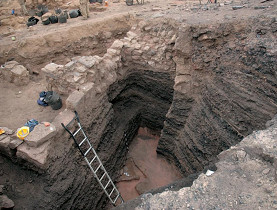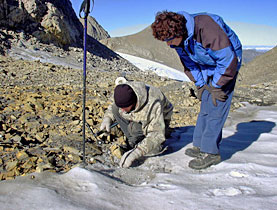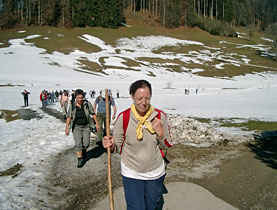Biblical mines unearthed but no King Solomon

An international team of scientists has dated a large-scale copper production centre in Jordan to the 10th century BC, the time of the biblical King Solomon's reign.
Stefan Münger of Bern University’s Biblical Institute, who examined finds from the site, tells swissinfo about the importance of the excavations even if there is still no evidence of the existence of the Old Testament ruler.
The team used high-precision radiocarbon dating and the expertise of scientists like Münger to push back the date of the metal production at the site of Khirbat en-Nahas in southern Jordan’s Faynan district to the 10th century, about 300 years earlier than previously thought.
Scientists in the 1970s and 1980s using different dating methods asserted that mining at the site did not start before the 7th century BC, and was therefore not connected to Solomon, who is said to have built Jerusalem’s first temple.
The shift in the dates means the mines would have been in operation during the reigns of the kings David and Solomon, possibly reopening the debate on the historical accuracy of the Old Testament.
swissinfo: There have been headlines in the media of King Solomon’s mines being rediscovered. How true is that statement?
Stefan Münger: I don’t think we can speak of King Solomon’s mines until we have a sign indicating, “stop here, these are King Solomon’s mines” or an inscription to that extent. Certainly these copper activities attest to large-scale economic productivity within this area at the time King Solomon was said to have lived.
The dating of the copper production certainly connects the site to the broader economic system of the whole region. What one can say is that the early kings of Israel might have had connections with this site or at least profited from its copper production, which was previously, and later as well, centred in Cyprus.
swissinfo: The findings also reopen the debate about the historical accuracy of the Old Testament. Do you feel they could give more ammunition to Christians who believe in a literal interpretation of the Bible?
S.M.: You can use this as an argument if you are discussing the historicity of the Bible. But we have to separate stories from history and there are of course historical seeds in the biblical text but they are not easy to recognise and sometimes we lack the tools to isolate these seeds.
Modern scholarship wouldn’t say the Old Testament is a historical book in its entity but there are some indications that there is a historical nucleus within the biblical accounts. I personally wouldn’t claim that King Solomon never existed.
We don’t have an argument for the historicity of King Solomon, nor do we have one against. It was the same in the case of King David. We didn’t have any evidence until 1993 when an inscription was found mentioning the dynasty of King David.
swissinfo: What were your contributions to the project?
S.M.: Professor Tom Levy from the University of California in San Diego sent me two pictures: one of an Egyptian amulet, which I knew existed and realised it was a significant find because of its chronological relevance.
The second was of a scarab belonging to a group of scarabs I’ve been working on. He sent the pictures without telling me the radiocarbon dating results. So I wrote a report on the scarab. I dated it and my results were more or less identical to those of the C14 results.
swissinfo: How did you date it?
S.M.: According to parallels found in the southern Levant and in Egypt, and trying to connect Levantine finds with Egyptian chronology, which is quite accurate and allows precise dating – occasionally even down to a decade.
swissinfo: In layman’s terms, how is this work done?
S.M.: You look at the object itself, how it’s made – the material used. In 99 per cent of the cases it’s soapstone but burnt in the final production stages. You look at the shape and the craftsmanship and finally the iconography. These amulets always have an image on the base, which can be dated because of the style, with each period having its own sets of motifs.
You have styles varying from period to period. If you are lucky there will be an inscription of a king’s name. Egyptian Pharaonic names helps to date them very precisely within a chronological framework.
swissinfo: What’s the significance of the scientific methodologies used at this site in southern Jordan for researching, for instance, the historical accuracy of other religious books?
S.M.: I think the main thing done by this team from the university in San Diego, which led the project, was to bring together highly specialised technology to a region, which also has religious importance. It’s not biblical archaeology as it used to be called – going out to find biblical cities or footprints of biblical personalities. It’s a way to find out more about life in ancient Israel during biblical times.
swissinfo: In that case, is it just a coincidence that the findings may give the Bible more credibility as a historical record?
S.M.: One did not rule that out from the start. There is a certain background and interest in this site and in this region. You could translate the scientific approach to other cultures and other regions, but you may not have sources with the same richness of the details found in the biblical text.
swissinfo: Is this the end of the excavations at this site or will they continue?
S.M.: It’s really just the beginning. Certainly it will be continued in order to learn more about how the site functioned and to learn about the economic and cultural orientation of the site. Which realms actually benefited from the exploitation of it? Could it have been the societies of Judah [southern area of ancient Israel] or Israel?
swissinfo: As a theologian, what do these findings mean to you?
S.M.: As I said, stories and history must be kept separate. A good story does not have to have a historical foundation, so a believer doesn’t need confirmation from an archaeologist for his or her beliefs. But the findings have great significance for a theologian interested in history.
If I were more a theologian interested in the spiritual or dogmatic aspects of theology, the findings would be meaningless. King Solomon is described as a great king – the king who gave his name to a whole era.
The name “Solomon” is rooted in the Hebrew word “peace”, and this is a theological idea which is highly valid but whether King Solomon had mines or not is in this case irrelevant.
swissinfo-interview: Dale Bechtel
The son and successor of King David, all that is known about Solomon comes from the Hebrew Bible, or the Old Testament.
King Solomon was known for his wisdom, his wealth and his writings. He is said to have composed 3,000 proverbs and 1,005 songs and written the Song of Songs, the Book of Proverbs and Ecclesiastes.
He established Israelite colonies outside his kingdom’s borders. Fortification of his empire necessitated a vast building programme, the crowning achievement of which was the Temple of Jerusalem.
He reorganized the nation into 12 tribes with 12 administrative districts. He is said to have had a harem of 700 wives and 300 concubines. After the ascension to the throne of his son Rehoboam, the northern tribes seceded and formed their own kingdom of Israel, bringing an end to Solomon’s empire.
The findings were published in the Proceedings of the National Academy of Sciences.
The scientists, led by Tom Levy of the University of California, San Diego, produced three-dimensional digital surveys of the site layout and location of the unearthed objects and dated them using high-precision radiocarbon methods.
The results “demonstrating intensive 10th-9th century BC industrial metallurgical activities conducted by complex societies” partly rehabilitate American archaeologist, Nelson Glueck, who worked in the 1930s.
Glueck asserted in his book, “The other side of Jordan”, that he had found King Solomon’s mines in the same area.
Described as carrying a trowel in one hand and a Bible in the other, Glueck was among a group considered to be conducting “biblical archaeology”.

In compliance with the JTI standards
More: SWI swissinfo.ch certified by the Journalism Trust Initiative











You can find an overview of ongoing debates with our journalists here . Please join us!
If you want to start a conversation about a topic raised in this article or want to report factual errors, email us at english@swissinfo.ch.